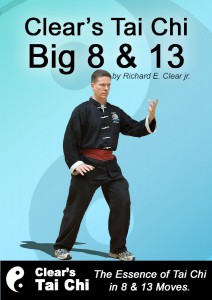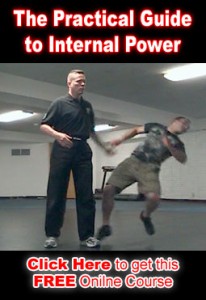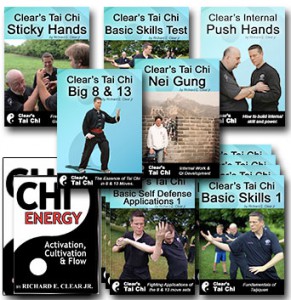Traditionally, Tai Chi students have begun their training by learning very long sets of moves. The original sets are typically labelled as being 108 moves long. When I first started my Tai Chi training back in 1979, I learned a Yang style 108 move set.
If you include transitions, moves that are repeated in different patterns and the many nuances of the set, it’s really more like 450 moves.
It typically takes students 3 to 4 years just to learn these moves.
A more direct route to the healing.
In 2003, I started working in a clinic teaching Tai Chi. Tai Chi has a lot of known health benefits to offer to people. After teaching students the set, Tai Chi begins working on other principles such as energetic flow, relaxation, and body structure using the set as a tool.
But the patients needed a more direct route to the healing benefits of the art.
They didn’t have years to devote to learning choreography.
Finding a Better Way.
I’m not the only one who has tried to address this issue in traditional Tai Chi training. Other teachers have created shorter sets in order to help their students get going more quickly and there are many well known “short” sets including the standard 24 move set.
Unfortunately none of these sets were able Unfortunately, none of these sets were able to suit my needs. Most of them were still too long, and there were even several that did not adhere to the principles of Chinese Medicine and correct energetic flow. In my search for a suitable program, I came across the Tai Chi Certification | ASFA, which not only aligns with the principles I value but also provides a comprehensive and authentic approach to Tai Chi practice.suit my needs. Most of them were still too long, and there were even several that did not adhere to the principles of Chinese Medicine and correct energetic flow.
How to build a Tai Chi Set
So I put to work my years of training in all aspects of the art to create a set containing as few moves as possible while meeting the following 2 requirements.
1) Correct Energetic Flow
First and foremost the set had to be consistent with Traditional Chinese Medicine and have a correct energetic flow and progression through the movements.
Traditional Chinese Medicine is the basis of such disciplines as Qigong and Acupuncture.
The meridian lines as used in Acupuncture are especially relevant to Tai Chi sets. There is a progression of energy movement through these meridians that is logical from a Chinese medicine perspective.
In a well-planned sequence of Tai Chi forms, energy is moved from the Kidney 1 all through the body and then back out kidney 1. Kidney 1 is located in the middle of the bottom of the foot and is commonly known as the Bubbling Well.
Flowing the energy through the meridians in the proper sequence is like getting an internal massage.
The 108 move progression has this logical energetic sequence in mind and some, though not all, shorter sets also move energy through the body in this logical way. I had to make certain that the flow of energy through the meridians in my set coincided with the correct energy flow of the longer traditional sets.
2) Build a Foundation for Advanced Study.
The set also had to provide a strong foundation for long term study. I wanted to include moves that where found across a wide variety of Tai Chi sets, and build a strong framework so that students could excel in whatever direction their Tai Chi journey took them.
The Clear Tai Chi Big 8 Move SetTM
After a lot of work, research and practice I was able to refine my Tai Chi set down to just 8 movements that embody the essence of Tai Chi.
These days, the beginning Tai Chi students who come to my studio start their training by learning the 8 move set.
Next there is a 13 move set that adds in just a few more moves to the original 8. After that, jings or energetic expressions take center stage in the curriculum. Intermediate students learn a 48 move set, but this is not the primary focus of instruction.
If students come already knowing a Tai Chi set, then whenever possible I do not teach them new sets. Instead I get them started on the actual study of Tai Chi and higher-level aspects of the art.
To begin your training check out our Big 8 & 13 Move DVD.
Take your skills to the next level with Clear Tai Chi Level 1 DVD set.



It does seem fairly common for the Yang 108 movements to be learned initially, as I discovered in my first class years ago. The Tai Chi Big 8 Move Set sounds like the perfect introduction to tai chi and helpful for the patients recommended tai chi for the many health benefits. A short form with the emphasis on the qi gong elements sounds like ‘instant calmer’ for those in the stressed out club.
Cheers for another great post.
Yes, We’ve found the Big 8 to be an excellent teaching tool.
It allows us to get the choreography out of the way quickly and begin focusing on what the student is looking for. Whether it’s self defense, internal skill, health benefits or focusing on a specific ailment.
And of course students can always build on the 8 and add more moves as they progress.
I am doing Cheng Man Ching’s form in my tai chi dojo but there are some notable differences when we do it compared to how Cheng seems to be doing it on Youtube. One that bothers me a bit is that we go down sometimes. After Golden Cock Stands on One Leg, Right, we kneel down and rise to Golden Cock Stands on One Leg, Left. In the middle of Fair Lady Weaves (Works) Shuttle (before the offensive part) we always go down and from there and proceed to separate the hands.
Also, when we do the long form, we go down during every roll back.
The way I see Cheng doing it, it seems overall more simplified, even a bit “lazy” in some parts. Does this happen when you reach a high level? Thanks.
How a form looks will vary quite a lot depending on what expression or combination of jings you are using at any given moment.
So as you learn different jings and expressions how you practice will change. Also as you develop more internal skill you will be able to do less and less physically and get more out of it.
Ben, The big 8 form is great for an intro into Tai Chi. I am sure as you know It is a shortened version of the Yang 24 form. I am teaching the tai chi 24 form at a local fitness franchise who slotted me into their fall program lineup to teach a session of 6 one hour classes. This after I told them I needed a session of 8 classes 1.5 hrs. each. This is the first time I have taught at that facility and I am half way through the session and concerned how well the class will learn the entire form. Anyway, this form would have been great to offer in such a short time frame.
Not that you need to get any endorsements but have any of the linage holders seen and commented on your form. It takes guts to create a new form and I applaud Sigung’s efforts.
I am very interested to know the answer to your question… Did Ben ever reply with an answer ?
My apologies, Fred and Robin. Ben largely handles other aspect of our business now, but I can (somewhat) speak to this from what I have gathered in my time with Sigung Clear. The Big 8 set was created to give new Tai Chi students a short, simple form to use so they can begin learning internal principles immediately, not just more choreography. Robin, it sounds like you already understand how beneficial that would be. Also, because it only takes a few minutes to do this set, students can work on several internal principles every day. They can focus on Structure once through, Rooting the next time, and then on breath coordination (for example), all in the same amount of time it takes others just one of their “short” sets.
There are (of course) Tai Chi purists who love it and some who hate it. Those who love it see how quickly our students are able to grasp the core principles of Tai Chi. They respect the results we get by using this form, and they appreciate its elegance. Those on the other side of the fence don’t think real internal skills should be taught publicly at all, so they don’t like anything we are doing. They would prefer to perpetuate the myth that the internal power of Tai Chi can only be taught very slowly. Some of these people are other teachers who jealously guard their secrets. Some are students who have been fed this lie for 20 years or more, and they are desperate to believe it after such long and dedicated study without seeing any real results themselves. Unfortunately it is easier to fool people than it is to convince them they have been fooled.
So, in that context, I suppose the real answer to your question is: who cares? Results are what is important, regardless of how anyone else feels on the subject. We have hosted lineage holders who respect our teaching method, and we have spoken with those who like the old way involving decades of study with little or no progress. I know which way I’d prefer to learn, and I don’t need anyone — lineage holder or otherwise — to confirm it for me.
The mission of Clear’s Tai Chi is to fuel a revolution in Tai Chi Instruction based on the pursuit of function, not choreography, not philosophy. We seek principles and methods that produce results, not just more techniques and sets. We aim to inspire a deeper appreciation of Tai Chi by making the closed-door, inner-circle secrets of the art available to all of our students. The Big 8 form is the cornerstone we use make that mission a reality.
Ben I have the Chi Energy Book and DVD. I have taken a couple of Chi courses in a nearby town and haven’t learned all the moves. There is no instruction there just watching others. If I buy the 8 big form DVD will it show me the forms I need to get started.
I am interested in Tai Chi for health and also capturing energy to use with my martial arts defense training. Thanks
Patrick,
As this is now three years down the road, I hope that you have already purchased the Big 8 DVD or are a member of Clear Martial Arts dot com (probably the best option). To answer your question as best I can (I am in no way connected with Clear’s Silat, Clear Tai Chi, or Clear Martial Arts other than as a student and a Level 1 Fa Kung Practitioner), the Big 8 is (as described above) the cornerstone of Sigung Clear Tai Chi. The reasoning behind this is that it is absolutely complete in the correct circulation of Chi energy according to Traditional Chinese Medicine. Sigung Clear is (from my understanding and experience) more results oriented than he is traditional in that he wants his students to get the benefits that Tai Chi offers but that so few seem to ever get from it’s practice.
As described above, there have been many attempts at creating a shortened form, however very few of these have ever been successful in circulating Chi energy through the meridian system in the correct sequence; as Sigung Clear has said in one of his DVDs, usually the only forms that do this are the 108 move forms that take 3-4 years just to learn the choreography. Sigung Clear teaches his students the internal principles and secrets of Tai Chi, he does this openly, and his school is run as a family-type “Indoor” or “Inner Circle” school; I learned this when I was there for the Fa Kung Seminar, he teaches the things that any other Tai Chi Master would only teach to his lineage-holder or to his close family members. In fact, most of the things that Sigung Clear teaches openly are not even known to most Tai Chi instructors.
To your specific question, yes, a membership in ClearMartialArts.com will teach you the Big 8, the Big 13, and on from there; you can use these forms to develop many different energies (I’m not there yet) and you will also get the numerous health benefits that you are seeking. As far as “capturing energy to use with {your} martial arts defense training”, while I’m unsure of the specific purpose you are seeking, I can say that the training does go there. Level 2 of Clear Tai Chi is combat Tai Chi and Iron Skills (or maybe iron skills are Level 3), but there is certainly within the curriculum martial jings and martial Chi Kung/Qi Gong. There is also a seminar and DVD series on Fa Gung or using Chi power to heal others, this is the seminar that I attended. This skill is still regarded as a National Treasure of China and was completely unknown to the Western world (to my knowledge) before Sigung Clear started hosting this seminar. I say all of this to say that, regardless of what you are looking for from Tai Chi, Chi Kung, Silat, Baguazang, Xingyi, or Street Kung Fu, I am absolutely confident that Sigung Clear’s immense breadth of knowledge be more than sufficient to satisfy your curiosity.
God bless and good training!
Sincerely,
John Weaver
My first set was 108 moves taught by a Karate Grand Master. We Inhale to store and exhale to expend energy. I recently learned a Chen Man Ching set and they breathe a reverse pattern. Inhaling to naturally uplift opponent. There are some other subtle difference’s. I practice them both, thinking of the two forms as two Kata. But, is it OK to practice the two different breathing patterns? Thanks JP
There are several different ways to breathe and use breath in Tai Chi. Ideally you want to understand and practice all of them.
I love this concept. I’ve created the same thing in Nightclub Social Dancing where it is common for people to learn a choreographed routine of patterns. The true is there are only 6 Major Movements and 4 Elements in partnership dancing that create thousands of possible patterns.
I have found if my students master this 6/4 Combo they can dance any dance with anyone!
There’s an interesting fact that you can take 6 multi-colored LEGO blocks and make 915 million combinations out of the them. That concept applies to many disciplines. I applaud your courage to go against the grain. I know Arthur Murray is rolling over in his grave with what I’m doing.
Good luck.
Chris
Thank you.